Shōgun — Why You Should Watch This 1980 Mini-series
–> Purchase the Blu-ray or DVD from Amazon.com
Shogun Mini-series Review (DVD)
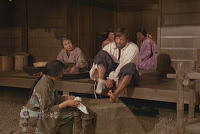 I was 10-years old when this mini-series was released in the U.S. As such, I would not have been allowed to watch this back then. Naturally, now that I’m into things Japanese, I had to check into this classic mini-series to see how it played out. Despite some minor issues with the late-70’s hair styles for the non-Japanese actors and some outdated and loud incident music for scenes featuring non-Japanese people, this mini-series really holds up well nearly 30-years after its creation.
I was 10-years old when this mini-series was released in the U.S. As such, I would not have been allowed to watch this back then. Naturally, now that I’m into things Japanese, I had to check into this classic mini-series to see how it played out. Despite some minor issues with the late-70’s hair styles for the non-Japanese actors and some outdated and loud incident music for scenes featuring non-Japanese people, this mini-series really holds up well nearly 30-years after its creation.
The Story, in Brief
 For those who don’t know, the mini-series is an adaptation of James Clavell’s Shōgun novel (buy the book from Amazon.com), which is a fictional account of the real shōgun TOKUGAWA Ieyasu (named Toranaga-sama/Lord Toranaga in the mini-series) and British Captain William Adams (Pilot-Major James Blackthorne in the mini-series). The story follows Blackthorne from his arrival in Japan after his ship is caught in storm. (As an aside, I’ve never read the book, so I don’t know how well it follows the novel.)
For those who don’t know, the mini-series is an adaptation of James Clavell’s Shōgun novel (buy the book from Amazon.com), which is a fictional account of the real shōgun TOKUGAWA Ieyasu (named Toranaga-sama/Lord Toranaga in the mini-series) and British Captain William Adams (Pilot-Major James Blackthorne in the mini-series). The story follows Blackthorne from his arrival in Japan after his ship is caught in storm. (As an aside, I’ve never read the book, so I don’t know how well it follows the novel.)
 Blackthorne’s journey has him go native (where he is known as “Anjin-san”) as he comes to see the Japanese not as barbarian savages, but a highly cultured society based on honor and might. Other stories that run in parallel are Blackthorne’s and his Christian Japanese teacher (and Toranaga’s translator) Mariko’s forbidden romance; the struggle for power between samurai lords Toranaga and Ishido; and the Jesuit’s fears over the idea of Blackthorne ruining their lucrative dealings in Japan.
Blackthorne’s journey has him go native (where he is known as “Anjin-san”) as he comes to see the Japanese not as barbarian savages, but a highly cultured society based on honor and might. Other stories that run in parallel are Blackthorne’s and his Christian Japanese teacher (and Toranaga’s translator) Mariko’s forbidden romance; the struggle for power between samurai lords Toranaga and Ishido; and the Jesuit’s fears over the idea of Blackthorne ruining their lucrative dealings in Japan.
The Non-Japanese Cast
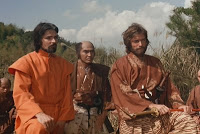 Richard Chamberlain plays the English James Blackthorne with no attempt to affect an English accent, but keeps his American one. Normally, something like this would annoy me since the other members of his crew do have accents, but Richard plays the character so well, it overcomes this weakness. His eventual use of Japanese is not too bad either. The only thing wrong is that Richard has a freaking 1979 hair style in 1600 Japan. He’s not the only one as there are others with out of place hair styles too and that’s a shame. The Japanese actors do have proper hair styles for the period though, as best as I can tell.
Richard Chamberlain plays the English James Blackthorne with no attempt to affect an English accent, but keeps his American one. Normally, something like this would annoy me since the other members of his crew do have accents, but Richard plays the character so well, it overcomes this weakness. His eventual use of Japanese is not too bad either. The only thing wrong is that Richard has a freaking 1979 hair style in 1600 Japan. He’s not the only one as there are others with out of place hair styles too and that’s a shame. The Japanese actors do have proper hair styles for the period though, as best as I can tell.
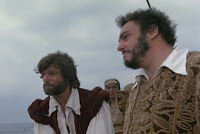 John Rhys-Davies (Indiana Jones, Lord of the Rings) has an important but small role in this ~9-hour mini-series (12-hours counting commercial time) as Portuguese Pilot Vasco Rodrigues. It is such a delight seeing him on screen and kind of funny hearing him bellow out Japanese in a fashion that the general American audience won’t notice, but for which those knowledgeable in Japanese will. I’ve never seen a movie or TV series that John plays a character in where I didn’t like his character. He comes darn close to stealing scenes in his early appearances and what happens to him at the end made me smile.
John Rhys-Davies (Indiana Jones, Lord of the Rings) has an important but small role in this ~9-hour mini-series (12-hours counting commercial time) as Portuguese Pilot Vasco Rodrigues. It is such a delight seeing him on screen and kind of funny hearing him bellow out Japanese in a fashion that the general American audience won’t notice, but for which those knowledgeable in Japanese will. I’ve never seen a movie or TV series that John plays a character in where I didn’t like his character. He comes darn close to stealing scenes in his early appearances and what happens to him at the end made me smile.
 Another notable non-Japanese performer comes from the Egyptian actor Damien Thomas, who plays the Jesuit priest Father Martin Alvito. Despite having a 1979-looking hair style, Damien manages to look like a devout Jesuit priest who might be evil or might be doing what he thinks is right. Father Alvito has an important role to advance the Jesuit portion of the story, but also acts as a translator many times when Mariko is not translating for Blackthorne. Damien’s Japanese sounded quite good, which is required since the Father Alvito character is so well connected to the ruling samurai as well as being a right-hand man for Father Dell’Aqua, the head of the Jesuit Church in Japan.
Another notable non-Japanese performer comes from the Egyptian actor Damien Thomas, who plays the Jesuit priest Father Martin Alvito. Despite having a 1979-looking hair style, Damien manages to look like a devout Jesuit priest who might be evil or might be doing what he thinks is right. Father Alvito has an important role to advance the Jesuit portion of the story, but also acts as a translator many times when Mariko is not translating for Blackthorne. Damien’s Japanese sounded quite good, which is required since the Father Alvito character is so well connected to the ruling samurai as well as being a right-hand man for Father Dell’Aqua, the head of the Jesuit Church in Japan.
The Japanese Cast
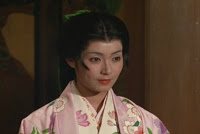 On the Japanese side, SHIMADA Yoko plays Mariko, the wife of samurai lord Buntaro-sama. She is also the personal translator for Toranaga-sama and part-time translator and Japanese teacher for Blackthorne. Mariko was only one of two Japanese actors who spoke any English and she had to have a dialog coach to assist her (though her English improves with time while retaining her Japanese accent). She captures the elegance and beauty of a Japanese lady very well so that Blackthorne’s falling for her is very understandable.
On the Japanese side, SHIMADA Yoko plays Mariko, the wife of samurai lord Buntaro-sama. She is also the personal translator for Toranaga-sama and part-time translator and Japanese teacher for Blackthorne. Mariko was only one of two Japanese actors who spoke any English and she had to have a dialog coach to assist her (though her English improves with time while retaining her Japanese accent). She captures the elegance and beauty of a Japanese lady very well so that Blackthorne’s falling for her is very understandable.
 Also of note on the Japanese side are MIFUNE Toshiro as Toranaga-sama, Frankie (Masatoshi) SAKAI as Yabu-sama, MEGURO Yuki as Omi-san, and KANEKO Nobuo as Ishido-sama. Actually, I may be biased, but I felt that while all the parts were well acted, those playing Japanese samurai were really good. Toshiro was a well-known Japanese actor in Japan and Frankie was a well known Japanese comedian who’d never done drama. Go figure.
Also of note on the Japanese side are MIFUNE Toshiro as Toranaga-sama, Frankie (Masatoshi) SAKAI as Yabu-sama, MEGURO Yuki as Omi-san, and KANEKO Nobuo as Ishido-sama. Actually, I may be biased, but I felt that while all the parts were well acted, those playing Japanese samurai were really good. Toshiro was a well-known Japanese actor in Japan and Frankie was a well known Japanese comedian who’d never done drama. Go figure.
Japanese Culture Respect
 One of the things that helps this mini-series stand up to the tests of time is that it is a well-written piece bereft of Hollywood influence. Since the entire production was filmed in Japan, studio executives in the U.S. could not interfere as by the time they received the film from the dailies, it was already way too late to make any real changes. Thus the story is a strong one and is one that I do not believe would be allowed today. Why? Because it is so deeply rooted in Japanese culture.
One of the things that helps this mini-series stand up to the tests of time is that it is a well-written piece bereft of Hollywood influence. Since the entire production was filmed in Japan, studio executives in the U.S. could not interfere as by the time they received the film from the dailies, it was already way too late to make any real changes. Thus the story is a strong one and is one that I do not believe would be allowed today. Why? Because it is so deeply rooted in Japanese culture.
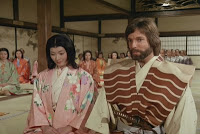 While the majority of Japanese dialog is translated for Blackthorne (and the audience) through either Mariko, Father Alvito, some another bilingual character (either a Jesuit priest or Blackthorne’s samurai retainer and former Jesuit monk Urano), or Orson Well’s narration, there is quite a bit of Japanese that does not get translated. Further, the production team has Blackthorne use Japanese honorifics quite a lot. While Toranaga or other samurai lord are often referred to as “Lord,” they are also referred to with the “sama” honorific, something more noticeable when subtitles are turned on.
While the majority of Japanese dialog is translated for Blackthorne (and the audience) through either Mariko, Father Alvito, some another bilingual character (either a Jesuit priest or Blackthorne’s samurai retainer and former Jesuit monk Urano), or Orson Well’s narration, there is quite a bit of Japanese that does not get translated. Further, the production team has Blackthorne use Japanese honorifics quite a lot. While Toranaga or other samurai lord are often referred to as “Lord,” they are also referred to with the “sama” honorific, something more noticeable when subtitles are turned on.
 Since the production team has the entire Japanese cast act in proper Japanese, proper honorific usage of “sama” and “dono” are used for the samurai, save for Omi-san and Blackthorne after he becomes known as “Anjin-san.” This is not the fault of the production team, but rather author James Clavell, who decided that the lower-ranking samurai “Omi” would be addressed as “Omi-san” and that Blackthorne would insist on being addressed as “Anjin-san.” In reality, Omi would be addressed as “Omi-sama” and in fact when the Japanese address him, that is how he is referred to. Also, the Japanese address Blackthorne as “Anjin-sama” at times with Toranaga and Yabu properly addressing him as “Anjin-dono” once he is made a samurai, which is also very proper.
Since the production team has the entire Japanese cast act in proper Japanese, proper honorific usage of “sama” and “dono” are used for the samurai, save for Omi-san and Blackthorne after he becomes known as “Anjin-san.” This is not the fault of the production team, but rather author James Clavell, who decided that the lower-ranking samurai “Omi” would be addressed as “Omi-san” and that Blackthorne would insist on being addressed as “Anjin-san.” In reality, Omi would be addressed as “Omi-sama” and in fact when the Japanese address him, that is how he is referred to. Also, the Japanese address Blackthorne as “Anjin-sama” at times with Toranaga and Yabu properly addressing him as “Anjin-dono” once he is made a samurai, which is also very proper.
Thoughts on the Series
 While there is some action in this mini-series, the real power of the series are the characters and the story as a whole. Watching Blackthorne go from dirty foreigner to Japanese at heart is a joy to watch. Despite their cruelty at times (and I have avoided all mention of this on purpose), all of the samurai lords come off as powerful men to be respected and I think that is key for gaining an understanding of feudal war era Japan. The political machinations of Toranaga against Ishido aren’t boring, but very intriguing. The political and religious aspects of the Jesuit story are also very interesting. I think the only mild weakness in the mini-series story comes in episode 2, where things slow down a bit plot-wise for a time.
While there is some action in this mini-series, the real power of the series are the characters and the story as a whole. Watching Blackthorne go from dirty foreigner to Japanese at heart is a joy to watch. Despite their cruelty at times (and I have avoided all mention of this on purpose), all of the samurai lords come off as powerful men to be respected and I think that is key for gaining an understanding of feudal war era Japan. The political machinations of Toranaga against Ishido aren’t boring, but very intriguing. The political and religious aspects of the Jesuit story are also very interesting. I think the only mild weakness in the mini-series story comes in episode 2, where things slow down a bit plot-wise for a time.
 In the end, Shōgun works because it respects the Japanese culture and does not feel the need to spoon feed the audience. Add to that the series having a well-crafted story and excellent character acting. If you have not seen this, I highly encourage you to do so, especially if you have an interest in Japanese culture or history. Even if you don’t, it should be noted that when this mini-series aired in the pre-VCR days of 1980 (there were VCR’s, they just very were rare to be in people’s home at the time due to the expense), business and restaurant sales declined because so many people stayed home to watch this. Reportedly, Shōgun caused the rise of Japanese restaurants in the U.S., especially sushi establishments. ^_^
In the end, Shōgun works because it respects the Japanese culture and does not feel the need to spoon feed the audience. Add to that the series having a well-crafted story and excellent character acting. If you have not seen this, I highly encourage you to do so, especially if you have an interest in Japanese culture or history. Even if you don’t, it should be noted that when this mini-series aired in the pre-VCR days of 1980 (there were VCR’s, they just very were rare to be in people’s home at the time due to the expense), business and restaurant sales declined because so many people stayed home to watch this. Reportedly, Shōgun caused the rise of Japanese restaurants in the U.S., especially sushi establishments. ^_^
DVD and Blu-Ray Set
 A quick note on the DVD box set — the five-episodes of the mini-series are spread over four discs with no actual episode breaks. Disc five contains the extras and some fascinating information on the series creation and production. The incidental music is too loud at times and sounds dated when it comes to westerners, but the traditional Japanese incidental music holds up pretty well. However, this is a minor complaint. A little more annoying is being forced to go through the Paramount logo with no way of bypassing.
A quick note on the DVD box set — the five-episodes of the mini-series are spread over four discs with no actual episode breaks. Disc five contains the extras and some fascinating information on the series creation and production. The incidental music is too loud at times and sounds dated when it comes to westerners, but the traditional Japanese incidental music holds up pretty well. However, this is a minor complaint. A little more annoying is being forced to go through the Paramount logo with no way of bypassing.
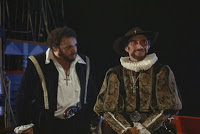 Update: I did buy the Blu-ray release as well. I’ll need to rewatch those so I can be refreshed on the video quality and extras. But I seem to recall the BD release looked much better than the DVD release.
Update: I did buy the Blu-ray release as well. I’ll need to rewatch those so I can be refreshed on the video quality and extras. But I seem to recall the BD release looked much better than the DVD release.
Bottom line: if you haven’t seen this already and you are reading this blog entry, go watch the mini-series and tell me what you think. ^_^



 May 26th, 2009
May 26th, 2009  AstroNerdBoy
AstroNerdBoy  Posted in
Posted in  Tags:
Tags: 
I only saw snippets of Shogun (Back when TNT aired it, once upon a time.), but it seems to be rather more faithful to Clavell’s book than Noble House was. John Rhys-Davies was in the latter, too, playing the mortal enemy of Pierce Brosnan’s character.
Clavell tended to be very detailed in his writings – but unfortunately he had too many subplots and characters running around that it often detracted from the stories.
C.T.
I saw this on the Hallmark Channel many years ago and remembered liking it. I’ll get the DVD set if there’s no immediate plan for a Blu-ray release.
I plan to read the novel at some point. I actually have it on order.
[…] That said, this chapter really has me stretching for things to comment on since there was a lot of saying nothing. Since I’m not really versed in Japanese history, I don’t know all of the possible avenues that CLAMP may go with these apparently reincarnated characters. I know Ieyasu was the first shogun and that his grandson Iemitsu was the third shogun. Beyond that, I know nothing (though Ieyasu’s life prior to becoming shogun was fictionalized in the novel and min-series Shogun). […]
About 1985, after much nagginng by friends did I finally pick up Clavell’s book. Eight hours later I finished it and was innoculated with nippon culture fever. Now I understood bushido. Not really, but I could see it. Only since retiring have I been able to renew the pleasure. “Love Hina” did it this time.
Recently, a new author, Susan Spann, has lit her own fireworks in the same period — Kyoto in 1600. Her hero, Hiro, is a secret shinobi who is tasked with his life to protect a jesuit priest. Together they solve murders. She includes lots of great ninja techno lore, like the iron hooks sewn in leather gloves that allow him to scale bare masonry walls quickly. Very cool stuff. Her newest, “Blade of the Samurai,” will be out next week! Her work would make great manga or anime.
I really should buy Clavell’s novel and read it. I should look into that Susan Spann book too.
Some stuff about the Amercan Susan Spann’s new book, “Blade of the Samurai.” Not only ninja lore does she display, but customs and status rules of Kyoto in mid 16th century does she include — like how deep a bow, from the neck or waist, and how long it’s held and who bows first, by samurai or not samurai, will send important messages. Very subtle nuances of respect, disbelief or challenge flow from the performance. Also, It’s very rude to point for any reason and to raise your voice for any reason. Finally, the family of an escaped criminal gets the same punishment the criminal would have! Thus, if your brother is a known murderer, you were seen with him, but you didn’t turn him in, you get beheaded first.
Apparently, Jesuit priests from Portugal were uncomfortably tolerated in Japan because some Portuguese merchants supplied modern, European weapons to the shogun! The Catholic Church was so strong in Portugal that it could insist that their priests go along with the merchants or no bennies to Japan. Not so fortuitously, intelligence benefits for both parties accrued. That explains away my quandry about why Western religion was tolerated at all.
We follow Hiro Hattori, a secret master shinobi whose purported role is translator for Father Mateo, but who must protect him at all costs and oh by the way solve murders with him. One very cute trick is that they both understand, write and speak Japanese and Portuguese, which they use against bad guys (who are not obvious at all) by feigning ignorance of the languages. The author very skilfully generates the interraction between Hiro and Father Mateo. For example, Hiro does not want or appreciate Father Mateo’s blessings. Gets angry. The contrast between Father Mateo’s apparently naive, simplistic heroism and Hiro’s skeptical foresight and black ops capability drives much of the action. They’re friends and their dichotomy works very well here in Ms. Spann’s work.
This definitely would generate a great anime or manga.
Thanks for the info. ^_^
[…] cited this example before, but I point to the success of the Shogun miniseries from 1980 (which I reviewed). While this wasn’t an adaptation of a Japanese novel, the producers took James […]
I just brought the Blu-Ray, the series hold’s up fairly well. Notably, the ship scenes. But I’m only 40 minutes or so through it.
If this and supergirl are any indication, it’s that CBS shows have really high budgets.
I’ll be interested in hearing what you think of the series. One of the reasons that the series works so well is that CBS actually had little say in the series. Since it was filmed in Japan, by the time the execs received the daily film results by ship, it was too late for them to object or make any changes to what was filmed. Thus the production team were able to keep things real.
Probably my all time favorite movie/mini-series. I definitely recommend it. I first saw it when I was about 13. My parents were watching it and I kept hanging out in their room at first but eventually went downstairs to watch the rest.
I recommend watching the full mini-series. The movie length version loses too many important elements of the story, focusing more on the romance aspects than the political, cultural and historical aspects that are really central to the story. The romance was comparatively a small part of the story.
Mine too.
I didn’t know there was a movie-length cut. My old DVDs (and now BDs) are the full mini-series.
Read the book, saw the mini-series but not the movie. One of my top 10 favorite books and I loved the TV version. I could see how hard they tried to follow the book I studied with interest and appreciated their alterations to accommodate time and content. They may have lost some of the complexity in the story but kept the main thread of it. I recently purchased the ABC 5 disc DVD and the book again. I forgot how raw parts of the book are. Now as I read it and watch the series again I’m most pleased by the stunning visuals that are now attached to my reading. The cinematography is plain but solid and from the era of big film unobtrusive camera work, but I’m glad because the shots are thoughtfully and carefully framed with minimal but appropriate camera movement. As a photographer I especially liked the subtle but strong use of long zoom lenses to combine several different aspects of a situation in one shot. I highly recommend both book and series as intense story telling.
I did recently purchase the novel with the fantasy of actually having time to read it. 😅 Maybe I’ll get some time (without losing my job or worse) as I’d love to read the source material.